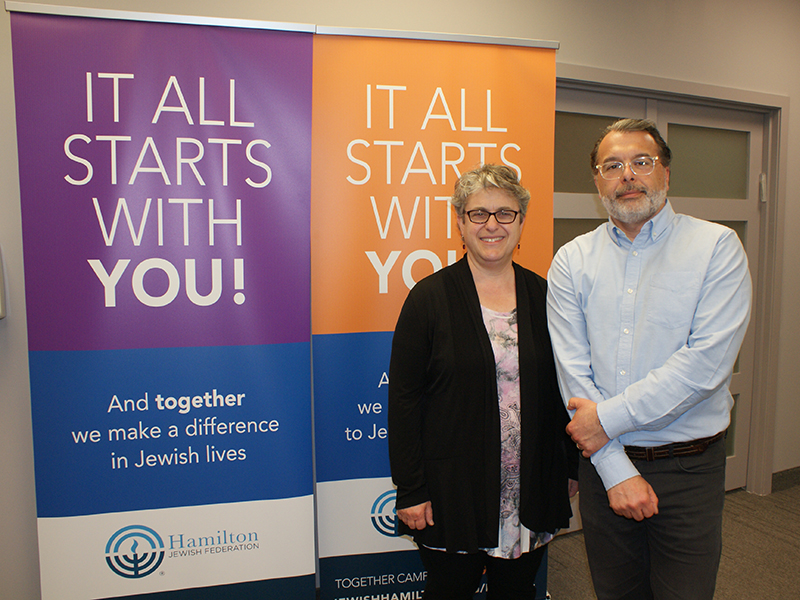HAMILTON, ONT. – After years of slow but steady population decline, the Hamilton Jewish Federation is mounting a new campaign to reverse the trend.
The Grow Hamilton initiative has two goals: to attract new Jewish residents to the area and to make them feel welcome once they’re here.
Committee chair Laura Wolfson said the community-wide effort involves all three local shuls and the local Israeli, Russian, South African and Jewish business communities.
“Before we can attract people, we have to have welcoming infrastructure,” said Wolfson. “We need a core of volunteers who will make personal contact with new arrivals, meet them at the airport, maybe invite them for coffee and even Shabbat dinner.
“We asked who is going to pick up a newcomer to the community and feed him his first dinner in Hamilton.… Every newcomer will have a personal contact on our committee.”
Without a direct effort to help newcomers find their place in Hamilton, Ont., Wolfson said too many people will fail to connect with the local community.
READ: FROM FARM TO BIMAH – THE LONG JOURNEY OF HAMILTON’S NEWEST CANTOR
“In Toronto, you can be Jewish almost by osmosis,” she said. “Our community is a lot smaller, so you have to make a real effort to connect.”
Modelled on a similar effort in Winnipeg that started in the late-1990s, the Hamilton project includes a detailed booklet outlining the Jewish resources in Hamilton, including the city’s three synagogues, a community centre, a social services agency, old age home, kosher butcher, two Jewish day schools and two afternoon Hebrew schools.
The booklet contains helpful hints, such as the fact that most of the Jewish community lives in the western part of Hamilton and the suburbs of Ancaster and Dundas. It even provides a list of real estate agents who are familiar with that part of town, as well as links for finding rental housing and accessing a wide variety of services in the area.
“What we want to do is show the full spectrum of Jewish possibilities in this city,” said Gustavo Rymberg, the executive director of the Hamilton Jewish Federation. “We’re showing people that whatever you want, we have it.”
The demographic trend the Federation is trying to fight is clear. Between 1991 and 2011 (the last year for which reliable statistics are available), Hamilton’s Jewish population fell from roughly 5,175 people to 5,110, a decline of just over 1.25 per cent. (The population in 2011 was actually up 9.2 per cent, or 430 people, from 2001.)
More troubling than the absolute number of Jewish people in Hamilton is the way the local population is skewing toward the elderly. Figures from the National Household Survey show that between 1991 and 2011, the number of people in the 45-64 age range rose by nearly 40 per cent, while the number in the zero-to-14 range fell by a similar amount. During the same period, people in the productive 25-44 age range fell 26.6 per cent, while the number of people over age 65 rose by 12.4 per cent.
For Rymberg, those numbers hint at the way the community is changing – some young families look outside the area for opportunities, while others look toward Hamilton for real estate options they couldn’t possibly afford in Toronto.
“I think that trend is going to continue in the future,” he said. “Hamilton is a much more vibrant community now than it was 10 years ago.”
Rymberg has personal knowledge of the benefits of such a program – the Winnipeg effort helped him find his feet in Canada after he and his family landed there in 1997. They fled their native Argentina following the 1994 Jewish community centre bombing that claimed 85 lives and injured hundreds more.
Elaine Goldstein, the chief executive of the Winnipeg Jewish Federation, said that city’s grow campaign was started in the face of serious population decline – from a peak of 21,000 in 1961, to about 13,690 in 2011. Today, the population is about 14,000.
Goldstein said the first Grow Winnipeg effort specifically targeted Argentina, because of the anti-Semitic wave sweeping the country at the time.
“We decided we would try to encourage people to come here,” she said. “We had heard there were a lot of people in Argentina who wanted to leave after the (community centre) bombing.”
Since its start, Goldstein said the program has helped bring 5,000 people to Winnipeg. Newcomers are met at the airport, guided around the city and given help filling out the required paperwork.
“We think this has really changed the nature of our community, that’s for sure,” she said.
